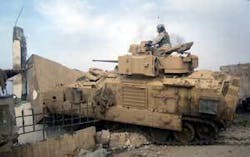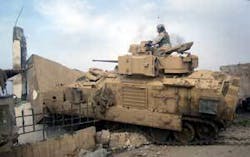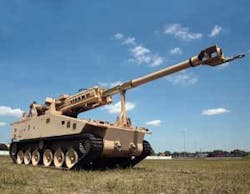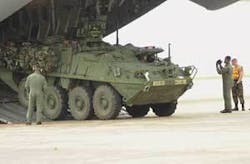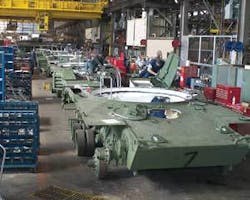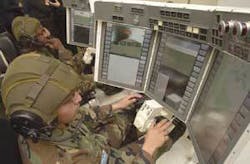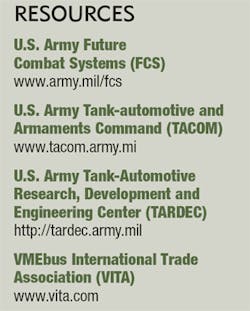Wheeled wonders and road warriors
Major defense industry vendors and contractors are contributing to the advancement and success of combat vehicles designed to take advantage of the best technologies available now and in the future.
By Courtney E. Howard
Vehicles are central to today’s military missions, providing far more than merely transportation to warfighters. As part of the Future Combat Systems (FCS) program, the U.S. Army is modernizing combat vehicles, and designing and developing next-generation units for the future.
Important U.S. Army ground and air vehicles on the battlefield of today, such as the M1 Abrams main battle tank, the M2 Bradley Fighting Vehicle, the M109 Paladin 155 mm self-propelled howitzer, and the AH-64 Apache attack helicopter, are all set to be replaced or augmented by future vehicles designed for the future network-centric battlefield.
“In addition to supporting the war effort, we are helping the FCS team develop technologies critical for the evolution of the manned ground vehicles and robotic vehicles that will replace the Abrams, Bradleys, and Paladins that the current force is using,” says Col. Bryan McVeigh, military deputy director of the U.S. Army Tank Automotive Research, Development, and Engineering Center (TARDEC).
A laboratory for advanced military ground systems and automotive technology, TARDEC is part of the Army Materiel Command’s Research Development and Engineering Command, and headquartered at the Detroit Arsenal in Warren, Mich. TARDEC experts are working on several initiatives, but their highest priority is supporting military operations in Iraq. “As we find out what challenges our soldiers are facing, we’re developing material solutions to issues that cannot be resolved through tactics, techniques, and procedures,” says McVeigh.
Old and new
A portion of the FCS aims to apply the lessons learned through recent war efforts and infuse current-force vehicles with the latest advancements and innovations.
“It would be foolish to take a tank built in 1990 and, as it comes back from Iraq, bring it back up to 1990 standards,” says McVeigh. “When we bring a tank back to retrofit it, we need to put in current technologies so it can perform for another 20 years.” Technology has matured, and TARDEC intends to take full advantage of it, he says.
“The FCS team is investing in computer upgrades, sensors, and active protection systems, and tying them all together on a network,” explains Mike MacPherson, director of business development at Curtiss-Wright Controls Embedded Computing in Leesburg, Va. “Some technologies are maturing faster than others, so groups of technology are collected in spinouts that provide new capabilities and incremental improvements to the current force fast.”
Spinout 1, for instance, provides unmanned ground sensors and intelligent munitions systems to augment the current-force brigade combat teams with better sensing capability and intelligent mines and munition systems. It also connects these systems via a network with battle command and situational awareness software, as well as an integrated computer system with which to manage those sensors and the data they collect.
At the same time, FCS calls for the creation of all-new vehicle platforms-18 of them, in fact. Included are nine variants of manned ground vehicles (MGVs)-four unmanned-aerial-vehicle (UAV) models and unmanned ground vehicles (UGVs) that range from a small UGV designed to investigate inside buildings, to large units providing countermine and assault support, to armored robotic vehicles that deliver heavy combat power without putting soldiers’ lives at risk.
“Our heavy forces-our Abrams and Bradleys, for example-can defeat any army in the world,” McVeigh says. “We truly have world-class heavy-brigade combat teams, but they take three to six Septembers to deploy; that is too long. Our light forces, such as the 82nd or 101st Airborne, can go anywhere in the world very quickly, but they don’t have the sustainment needed. We need a force that can deploy rapidly and face major combat operations-that’s where FCS comes in.”
IP everywhere
Central to the Army’s modernization of combat vehicles is a migration away from platform-centric warfare to network-centric warfare. Network-centricity, or net-centricity as it has been called, enhances a soldier’s situational awareness, broadens his vision, and gives him an edge in battle. That network-centric vision, a driving force of FCS programs, connects the 18 vehicles, as well as the soldiers, while also fusing the data from their sensor feeds to provide commanders with a clear picture of virtually everything happening on the battlefield.
The Abrams tank, arguably the premier combat system in the current force, is a prime example of a platform-centric view of warfare. It operates in a platoon, but it is a platoon of stand-alone platforms, explains MacPherson. Platform-centric vehicles use a data network that moves information from one system to another within the same vehicle; it does not necessarily deliver data from the vehicle to another location on the battlefield. FCS combat vehicles, conversely, serve as network-attached peripherals in an Internet protocol-based network.
“The Abrams, Bradley, Paladin, and Apache weren’t designed to talk to each other or to flow information back and forth,” McVeigh says. “They use the same kind of radios, but that was about it. Now the Army is developing a system of systems that fuses all the information together, such that the data received from a small unmanned ground vehicle in a sewer system can be fed not only to the platoon leader, but also to the company commander, other companies, and battalions up through brigade and beyond; it’s a capability we’ve never had.”
“In the platform-centric environment, you have real-time knowledge of only your own situation, as opposed to the network-centric world, in which you have real-time knowledge of the entire battlefield,” MacPherson says. “It is local situational awareness vs. global or theater situational awareness.”
Knowledge of neighbors
In past battlefield scenarios, a soldier in a tank had only local situational awareness; he knew his enemies’ whereabouts by communicating over a voice radio network or by seeing the enemies in close proximity. The Army has dedicated significant resources, including several programs and considerable money, to expanding the warfighter’s situational awareness.
“The FCS goal is that, as he comes into a particular area of operation, a commander or other soldier in an individual tank platoon knows the lay of the land, including the position of both friend and foe, through a network-centric capability,” MacPherson says. “The concept is this: If you know where your enemies are before you encounter them, you can ‘engage out of contact’ and either maneuver around the enemy or engage it without being directly in that enemy’s line of sight.”
TARDEC experts are infusing vehicles in the current force with a combination of commercial satellite communications and commercial tracking mechanisms as part of Blue Force Tracker, and tying them to the Force 21 Battle Command Brigade and Below (FBCB2) program.
“Blue Force Tracking involves knowing where all your friendlies are,” MacPherson explains. “With GPS, radio, and computer technologies, you have global situational awareness. The next step is to tie these sensor assets together to know where enemies are. So now you are able to distribute information with respect to target identification, target acquisition, and classification of targets across the battlefield.
Legacy vehicles in the current force will benefit from Blue Force Tracking, whereas new FCS vehicles takes it a step further to combine sensor data to form a cohesive and comprehensive view of the battle space. “Blue force tracking tells you where everyone is on the battlefield, and that’s great,” McVeigh says, “but the FCS network will not only tell you where everyone is, but fuse the data from the sensors to provide a clearer picture of the battlefield. The network allows us take aviation assets from our Air Force, Navy, and Marine Corp. brethren and fuse it into the same data picture.”
Intraplatform connectivity
For the network-centric vision to work, especially across all the armed services, engineers and systems integrators in the FCS team face the challenge of seamlessly integrating the many different vehicle platforms on the overall network. In doing so, executives at such large industry players as Curtiss-Wright are noting a push toward switched serial fabric interconnects, and a move away from parallel buses.
“With switched serial fabric interconnectivity, it becomes a system of systems or of subsystems within a platform,” MacPherson says. “You are now able to route from the local network of a vehicle platform to the corporate network, which could be the battlefield or the Global Information Grid. In the embedded computing space, it is driving us to provide network-attached single-board computers, ruggedized switches that go inside these vehicles, and ruggedized routers.”
MacPherson acknowledges, however, that connecting seemingly disparate platforms is no easy task. A main impediment to adding technology to combat vehicles, whether new or old, is what is known as SWaP-C-size, weight, power, and cooling.
“You typically have a space allocation in vehicles, so we have to try to find ways to increase our functional density, which is our ability to get more electronics into an existing space,” MacPherson says. “A lot more electronics are going into these platforms, and the space within these platforms for electronics is becoming more and more constrained.”
Electronics packaging in vehicles historically has involved the box-a line-replaceable unit (LRU) with cards in it. The current trend is toward modules that perform several functions, and a commonality of electronics. The use of modules distributes functionality and shares resources throughout the network, and it is driving some of the packaging away from the current VME standard.
“These new hardware technologies bring about advancements in battle management,” MacPherson says. “There is an operational concept called time-sensitive targeting which says when a threat pops up on your battlefield, you have a certain time period in which to react and provide some effect on that threat. To do that, you need to be able to provide enough information to the commander who has to make the determination to act on that threat within the allotted timeframe. By sharing and fusing information on a network, you are turning raw sensor data into actionable information-going from detecting a blip on a radar to determining that it’s a particular threat or friendly, to knowing whether it is a tank or a soldier.” Ensuring the transmission and receipt of critical information on a network basis and in real time involves a great deal of processing, and the latest data-transfer technologies.
“The VME and National Trade Association are about to release a new standard called VPX, based on Vita 46 for the electrical interface and Vita 48 for the mechanical interface,” MacPherson continues. “It offers more flexibility in how you integrate electronics into these platforms. The high-speed serial capability and being able to tie these compute elements together via a switched fabric, rather than a parallel back plane, environment provides flexibility in packaging and enclosures. The architectures of combat vehicles are going to change based on this trend.”
More electronics, fewer men
“The other trend is to get more soldiers out of the vehicle,” says Doug Patterson, vice president of worldwide sales and marketing at AiTech Defense Systems Inc. in Chatsworth, Calif. “The idea is to go from a three-man crew in a main battle tank to a two-man crew and, therefore, you would add more electronics to make up for the deficiency. Putting the warfighter in a safer area, such as through a host of unmanned vehicles, is absolutely a trend and part of the FCS program.”
“We can do more with less because our technologies have matured to such a degree,” McVeigh says. “The current towed howitzer has a crew of eight men; the NLOS-C [non-line-of-sight cannon], the first vehicle to come out of the FCS program has a crew of two. The incredible technologies we’ve gotten out of the Crusader program-its autoloader, data processing, and so on-enable two men to do the job of eight. We’re taking soldiers out of harm’s way by adding electronics, computer capability, and systems engineering.”
Modularity and distributed architectures
As more information technology (IT) systems are employed in current and future combat vehicles, those involved in the FCS program must deal with the rapid obsolescence of this technology. After all, a computer system’s lifecycle is typically a great deal shorter than that of a tank.
“In two years, computers go from the latest and greatest to almost obsolete,” MacPherson says. Yet, many in the Department of Defense still seek 10-, 15-, and 20-year product lifecycles. “In a lot of cases, the electronics used in prototypes were obsolete by the time they got into production, due to the length of these programs. When the FCS program began in the late 1990s, the intention was to field the technology in 2012. How many upgrades to PowerPC and Intel processors are going to happen in that time frame? A lot. Also, much more software is being installed in these combat systems, and software upgrades contribute to more frequent hardware updates. Every couple years, even during development, deliberate upgrades of the core vehicle electronics and integrated computer system are needed as they approach the initial operating capability of the FCS unit of action. As combat systems add more IT, technology insertion and technology refresh will become more deliberate and proactive, opposed to reactive obsolescence management.”
FCS research and development efforts are, in this way, concentrating on system modularity, open architectures, and greater adoption of commercial-off-the-shelf (COTS) products to ensure the seamless integration of the latest technologies as they arise.
“Distributed intelligence and common elements are the future,” Patterson says. “If we, throughout the defense and aerospace industry, have learned anything, it is that we have to stop building one-of-a-kind solutions that are specific to one platform. When you’re in a firefight and something stops working, you need to be able to pull devices off some other vehicle and get up and running quickly. A major helicopter program has gone down the path of technology obsolescence and it has created ‘hangar queens’-the concept of pulling mission computers and control elements out of existing aircraft to keep vehicles flying over in Kosovo, Iraq, and Afghanistan-because they can’t support that platform anymore. That’s a bad thing. The need for technology insertion and spiral upgrade programs is a valuable lesson that has been learned. The one constant in this world is change. You can’t build a vehicle one way and say it will be good for 20 years. Those working on FCS have gotten that message, and they’re going electronic; it allows you to project defensive forces quicker, better, and in greater numbers worldwide.”
Aitech has received that message as well. The company elected to build the only version of a remote interface controller (RICC) that will be integrated into all the different vehicles that are part of FCS mounted cavalry systems. “If you have a critical mission in which one vehicle’s RICC units or RIUs go down, you can pull it off a hummer, drop it in, and it works. It performs exactly the same function as the one you just pulled out.”
The overall issue of control is another focal point of FCS combat vehicle modernization and development efforts. Older combat vehicles like the expeditionary fighting vehicle (EFV) used a mix of electrical motors and hydraulics during operation, such as when moving turrets or changing the elevation of its barrels. The FCS program, however, calls for a move to electronic actuation.
“Electronic actuation involves pulse-code modulation motors with intelligent controllers that use positive feedback to actuate various functions of the vehicle, whether its ammo doors, the rear troop door, or hatches or automatic ammo loaders,” explains Patterson. “All the things within the vehicle are moving to electronic actuation, rather than the old brute-force valve thing. That’s a major change.
“Lots of things are happening today, and FCS is leading the charge,” continues Patterson. “Why is it that our troops have been successful? It is because they have cutting-edge technology out there and it’s ahead of the pack.”
“The FCS program affects nearly every state in the union,” says McVeigh. “It is pulling in the best and the brightest from all the defense industry. The lead systems integrator is Boeing and there are more than 40 first-tier contractors. Essentially all of the major players are involved in this program, because we need their expertise. And the fact that companies that used to be competitive are working together, and doing it very effectively, is just an incredible success story.”
